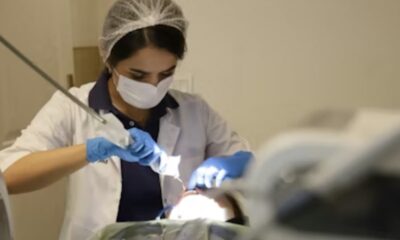Science
Abandoned Structures Fuel Rising Heat in Houston, Study Reveals

A recent study conducted by researchers at Texas A&M University highlights the significant impact of abandoned buildings and vacant lots on surface temperatures in Houston, which ranks among the ten hottest cities in the United States. The research, led by lecturer Dingding Ren, utilized thermal imaging equipment mounted on drones to map surface temperatures across seven sites in the city, revealing alarming findings about urban heat dynamics.
The team collected over 1,400 drone images and integrated them with data from NASA’s LandSat satellite to evaluate heat risks across various zones, including residential, commercial, and industrial areas. The findings indicate that vegetated or vacant land significantly reduces land surface temperatures, while abandoned structures contribute to higher temperatures due to their heat-retaining surfaces.
Impact of Urban Heat on Vulnerable Communities
According to Ren, “The research found that concrete, asphalt, and gravel absorb heat during the day and release it overnight, while lots with vegetation cool the surrounding area significantly.” The study reveals that surface temperatures in vegetated areas can be as much as 20 degrees Fahrenheit cooler compared to those dominated by abandoned buildings and paved lots.
Furthermore, the analysis of publicly available demographic data shows a concerning correlation between elevated surface temperatures and higher social vulnerability. Communities experiencing increased heat are more susceptible to adverse effects during natural disasters, underscoring the need for immediate action.
Ren emphasizes the importance of implementing targeted cooling strategies, particularly passive cooling mechanisms, to mitigate heat risks and enhance climate resilience in disadvantaged communities. “The finding highlights the need for targeted cooling strategies,” he said, “especially passive cooling mechanisms, like great infrastructure and land reuse.”
Opportunities for Green Infrastructure
Houston currently has approximately 45,000 acres of vacant land and 10,000 acres of abandoned buildings, presenting a significant opportunity for the enhancement of green infrastructure. Ren views these areas as “missed opportunities” to implement passive cooling systems that could help improve the local microclimate.
Passive cooling mechanisms are design strategies aimed at removing heat or preventing heat from entering a building or specific location. By transforming vacant and abandoned spaces into green areas, Houston could not only reduce surface temperatures but also promote environmental sustainability and community well-being.
As the city grapples with rising temperatures, the findings from Texas A&M University call for a coordinated effort to revitalize these underutilized spaces. By investing in green infrastructure, Houston can better prepare its communities for the challenges posed by extreme heat and climate change.
-

 Technology5 months ago
Technology5 months agoDiscover the Top 10 Calorie Counting Apps of 2025
-

 Health2 months ago
Health2 months agoBella Hadid Shares Health Update After Treatment for Lyme Disease
-

 Health3 months ago
Health3 months agoErin Bates Shares Recovery Update Following Sepsis Complications
-

 Technology4 months ago
Technology4 months agoDiscover How to Reverse Image Search Using ChatGPT Effortlessly
-

 Technology1 month ago
Technology1 month agoDiscover 2025’s Top GPUs for Exceptional 4K Gaming Performance
-

 Technology2 months ago
Technology2 months agoElectric Moto Influencer Surronster Arrested in Tijuana
-

 Technology5 months ago
Technology5 months agoMeta Initiates $60B AI Data Center Expansion, Starting in Ohio
-

 Technology5 months ago
Technology5 months agoRecovering a Suspended TikTok Account: A Step-by-Step Guide
-

 Health4 months ago
Health4 months agoTested: Rab Firewall Mountain Jacket Survives Harsh Conditions
-

 Lifestyle5 months ago
Lifestyle5 months agoBelton Family Reunites After Daughter Survives Hill Country Floods
-

 Technology4 months ago
Technology4 months agoHarmonic Launches AI Chatbot App to Transform Mathematical Reasoning
-

 Technology3 months ago
Technology3 months agoUncovering the Top Five Most Challenging Motorcycles to Ride



















